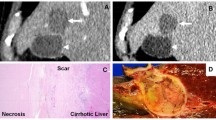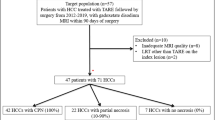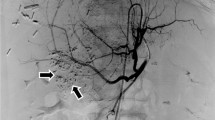Abstract
Objective
To investigate whether volumetric enhancement on baseline MRI and volumetric oil deposition on unenhanced CT would predict HCC necrosis and response post-TACE.
Method
Of 115 retrospective HCC patients (173 lesions) who underwent cTACE, a subset of 53 HCC patients underwent liver transplant (LT). Semiautomatic volumetric segmentation of target lesions was performed on dual imaging to assess the accuracy of predicting tumour necrosis after TACE in the whole cohort and at pathology in the LT group. Predicted percentage tumour necrosis is defined as 100 % - (%baseline MRI enhancement - %CT oil deposition).
Results
Mean predicted tumour necrosis by dual imaging modalities was 61.5 % ± 31.6%; mean percentage tumour necrosis on follow-up MRI was 63.8 % ± 31.5 %. In the LT group, mean predicted tumour necrosis by dual imaging modalities was 77.6 % ± 27.2 %; mean percentage necrosis at pathology was 78.7 % ± 31.5 %. There was a strong significant correlation between predicted tumour necrosis and volumetric necrosis on MRI follow-up (r = 0.889, p<0.001) and between predicted tumour necrosis and pathological necrosis (r = 0.871, p<0.001).
Conclusion
Volumetric pre-TACE enhancement on MRI and post-TACE oil deposition in CT may accurately predict necrosis in treated HCC lesions.
Key Points
• Imaging-based tumour response can assist in therapeutic decisions.
• Lipiodol retention as carrier agent in cTACE is a tumour necrosis biomarker.
• Predicting tumour necrosis with dual imaging potentially obviates immediate post-treatment MRI.
• Predicting tumour necrosis would facilitate further therapeutic decisions in HCC post-cTACE.
• Pre-TACE MRI and post-TACE CT predict necrosis in treated HCC.






Similar content being viewed by others
Abbreviations
- ADC:
-
Apparent diffusion coefficient
- CI:
-
Confidence interval
- CT:
-
Computed tomography
- cTACE:
-
Conventional TACE
- DEB-TACE:
-
Drug-eluting bead-TACE
- EASL:
-
European Association for Study of Liver Disease
- HAP:
-
Hepatic arterial phase
- HCC:
-
Hepatocellular carcinoma
- ICC:
-
Intra-class Correlation Coefficient
- LT:
-
Liver transplant
- mRECIST:
-
modified RECIST
- MRI:
-
Magnetic resonance imaging
- PVP:
-
Portal venous phase
- RECIST:
-
Response Evaluation Criteria in Solid Tumors
- SD:
-
Standard deviation
- TACE:
-
Transarterial chemoembolization
References
Bray F, Ferlay J, Laversanne M et al (2015) Cancer incidence in five continents: inclusion criteria, highlights from volume X and the global status of cancer registration. Int J Cancer 137:2060–2071
Lanza E, Donadon M, Poretti D et al (2016) Transarterial therapies for hepatocellular carcinoma. Liver Cancer 6:27–33
Tsurusaki M, Murakami T (2015) Surgical and locoregional therapy of HCC: TACE. Liver Cancer 4(3):165–175
Forner A, Ayuso C, Varela M et al (2009) Evaluation of tumor response after locoregional therapies in hepatocellular carcinoma: are response evaluation criteria in solid tumors reliable? Cancer 115:616–623
Hayano K, Lee SH, Sahani DV (2015) Imaging for assessment of treatment response in hepatocellular carcinoma: current update. Ind J Radiol Imaging 25:121–128
Monsky WL, Kim I, Loh S et al (2010) Semiautomated segmentation for volumetric analysis of intratumoral ethiodol uptake and subsequent tumor necrosis after chemoembolization. AJR Am J Roentgenol 195:1220–1230
Ray S, Hagge R, Gillen M et al (2008) Comparison of two-dimensional and three-dimensional iterative watershed segmentation methods in hepatic tumor volumetrics. Med Phys 35:5869–5881
Kwan SW, Fidelman N, Ma E, Kerlan RK Jr, Yao FY (2012) Imaging predictors of the response to transarterial chemoembolization in patients with hepatocellular carcinoma: a radiological-pathological correlation. Liver Transpl: Off Publ Am Assoc Study Liver Dis Int Liver Transpl Soc 18:727–736
Yu SC, Hui JW, Hui EP et al (2014) Unresectable hepatocellular carcinoma: randomized controlled trial of transarterial ethanol ablation versus transcatheter arterial chemoembolization. Radiology 270:607–620
Agnello F, Salvaggio G, Cabibbo G et al (2013) Imaging appearance of treated hepatocellular carcinoma. World J Hepatol 5(8):417–424
Ito K, Honjo K, Fujita T et al (1995) Therapeutic efficacy of transcatheter arterial chemoembolization for hepatocellular carcinoma: MRI and pathology. J Comput Assist Tomogr 19:198–203
Chapiro J, Duran R, Lin M et al (2015) Identifying staging markers for hepatocellular carcinoma before transarterial chemoembolization: comparison of three-dimensional quantitative versus non-three-dimensional imaging markers. Radiology 275:438–447
Sultana S, Awai K, Nakayama Y et al (2007) Hypervascular hepatocellular carcinomas: bolus tracking with a 40-detector CT scanner to time arterial phase imaging. Radiology 243:140–147
Chapiro J, Wood LD, Lin M et al (2014) Radiologic-pathologic analysis of contrast-enhanced and diffusion-weighted MR imaging in patients with HCC after TACE: diagnostic accuracy of 3D quantitative image analysis. Radiology 273(3):746–758
McHugh ML (2012) Interrater reliability: the kappa statistic. Biochem Med 22(3):276–282
Paul SB, Sharma H (2014) Role of transcatheter intra-arterial therapies for hepatocellular carcinoma. J Clin Exp Hepatol 4:S112–S121
Pompili M, Francica G, Ponziani FR, Iezzi R, Avolio AW (2013) Bridging and downstaging treatments for hepatocellular carcinoma in patients on the waiting list for liver transplantation. World J Gastroenterol 19:7515–7530
Lo CM, Ngan H, Tso WK et al (2002) Randomized controlled trial of transarterial lipiodol chemoembolization for unresectable hepatocellular carcinoma. Hepatology 35(5):1164–1171
Sato Y, Watanabe H, Sone M et al (2013) Tumor response evaluation criteria for HCC (hepatocellular carcinoma) treated using TACE (transcatheter arterial chemoembolization): RECIST (response evaluation criteria in solid tumors) version 1.1 and mRECIST (modified RECIST): JIVROSG-0602. Ups J Med Sci 118:16–22
Takayasu K, Arii S, Matsuo N et al (2000) Comparison of CT findings with resected specimens after chemoembolization with iodized oil for hepatocellular carcinoma. AJR Am J Roentgenol 175:699–704
Liu YS, Chuang MT, Tsai YS, Tsai HM, Lin XZ (2012) Nitroglycerine use in transcatheter arterial (chemo)embolization in patients with hepatocellular carcinoma and dual-energy CT assessment of Lipiodol retention. Eur Radiol 22:2193–2200
Bonekamp D, Bonekamp S, Halappa VG et al (2014) Interobserver agreement of semiautomated and manual measurements of functional MRI metrics of treatment response in hepatocellular carcinoma. Eur J Radiol 83:487–496
Valero V 3rd, Amini N, Spolverato G et al (2015) Sarcopenia adversely impacts postoperative complications following resection or transplantation in patients with primary liver tumors. J Gastrointest Surg 19:272–281
Samrao D, Wang D, Ough F et al (2012) Histologic parameters predictive of disease outcome in women with advanced stage ovarian carcinoma treated with neoadjuvant chemotherapy. Transl Oncol 5:469–474
Riaz A, Lewandowski RJ, Kulik L et al (2010) Radiologic-pathologic correlation of hepatocellular carcinoma treated with chemoembolization. Cardiovasc Intervent Radiol 33:1143–1152
Kim DY, Ryu HJ, Choi JY et al (2012) Radiological response predicts survival following transarterial chemoembolisation in patients with unresectable hepatocellular carcinoma. Aliment Pharmacol Ther 35(11):1343–1350
Wang Z, Lin M, Lesage D et al (2014) Three-dimensional evaluation of lipiodol retention in HCC after chemoembolization: a quantitative comparison between CBCT and MDCT. Acad Radiol 21:393–399
Corona-Villalobos CP, Halappa VG, Geschwind JF et al (2015) Volumetric assessment of tumour response using functional MR imaging in patients with hepatocellular carcinoma treated with a combination of doxorubicin-eluting Rbeads and sorafenib. Eur Radiol 25:380–390
Funding
The authors state that this work has not received any funding.
Author information
Authors and Affiliations
Corresponding author
Ethics declarations
Guarantor
The scientific guarantor of this publication is Ihab R Kamel.
Conflict of interest
The authors of this manuscript declare no relationships with any companies whose products or services may be related to the subject matter of the article.
Statistics and biometry
No complex statistical methods were necessary for this paper.
Informed consent
Written informed consent was waived by the Institutional Review Board.
Ethical approval
Institutional Review Board approval was obtained.
Methodology
• retrospective
• diagnostic study
• performed at one institution
Rights and permissions
About this article
Cite this article
Najmi Varzaneh, F., Pandey, A., Aliyari Ghasabeh, M. et al. Prediction of post-TACE necrosis of hepatocellular carcinoma usingvolumetric enhancement on MRI and volumetric oil deposition on CT, with pathological correlation . Eur Radiol 28, 3032–3040 (2018). https://doi.org/10.1007/s00330-017-5198-9
Received:
Revised:
Accepted:
Published:
Issue Date:
DOI: https://doi.org/10.1007/s00330-017-5198-9




